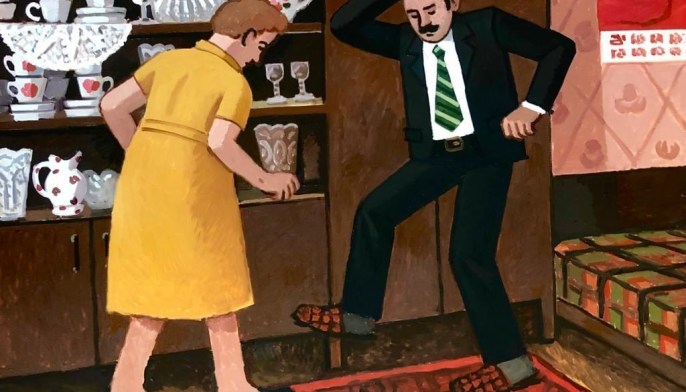
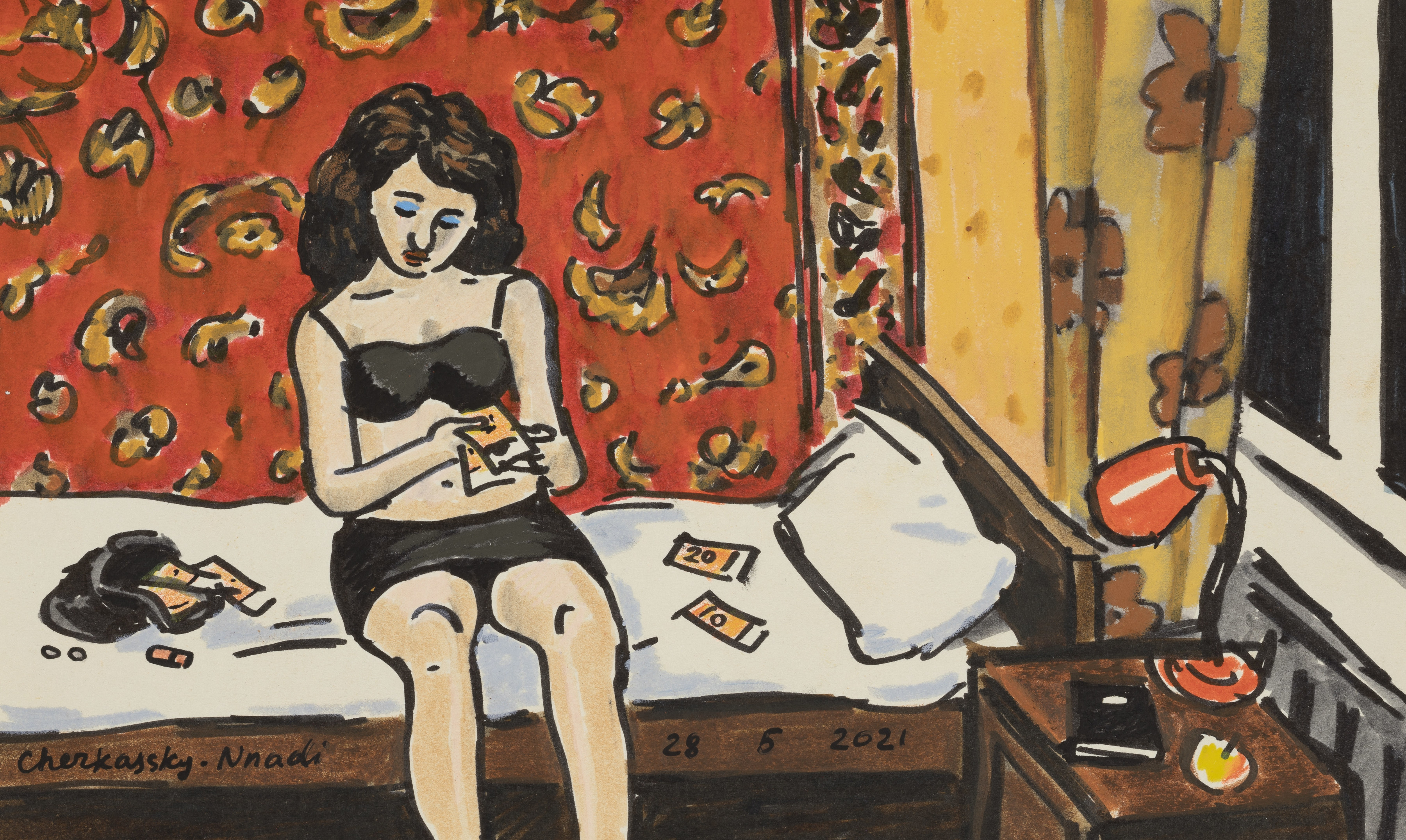
Zoya Cherkassky, Untitled, 2021
Zoya Cherkassky: Women Who Work
An online exhibition in conversation with Alison M. Gingeras
July 22 – October 02, 2021
For Women Who Work, Zoya Cherkassky takes a detour to explore the topic of contemporary female sex work. The series of new drawings was triggered by the horrific story of Viktor Mokhov, better known as the “Skopin Maniac.” After abducting two teenage girls in 2000, whom he raped and held hostage in a subterranean bunker for nearly four years, Mokhov served only seventeen years in a Russian prison. Upon his release this year, the Russian media treated Mokhov as a celebrity, much to the chagrin of human rights activists across the globe.
Cherkassky’s drawings highlight the gendered power dynamics, exploitation, and shame associated with the harsh reality of the sex work industry. Simultaneously, by depicting the comradery and banality of the workers’ everyday lives, she presents a worldview in which her subjects are not defined merely as archetypes.
Alison M. Gingeras lives and works in New York City and has served as curator at the Solomon R. Guggenheim Museum, the National Museum of Modern Art, and Centre Pompidou Paris. Currently, she serves as an adjunct curator at Dallas Contemporary and a guest curator at the Museum of Contemporary Art in Miami. Gingeras is known for her scholarly yet anarchic approach to art history and curated Zoya Cherkassky’s last show, Lost Time, at Fort Gansevoort.
Below, Gingeras and Cherkassky discuss the influence and subject matter of the artist’s recent series of drawings.
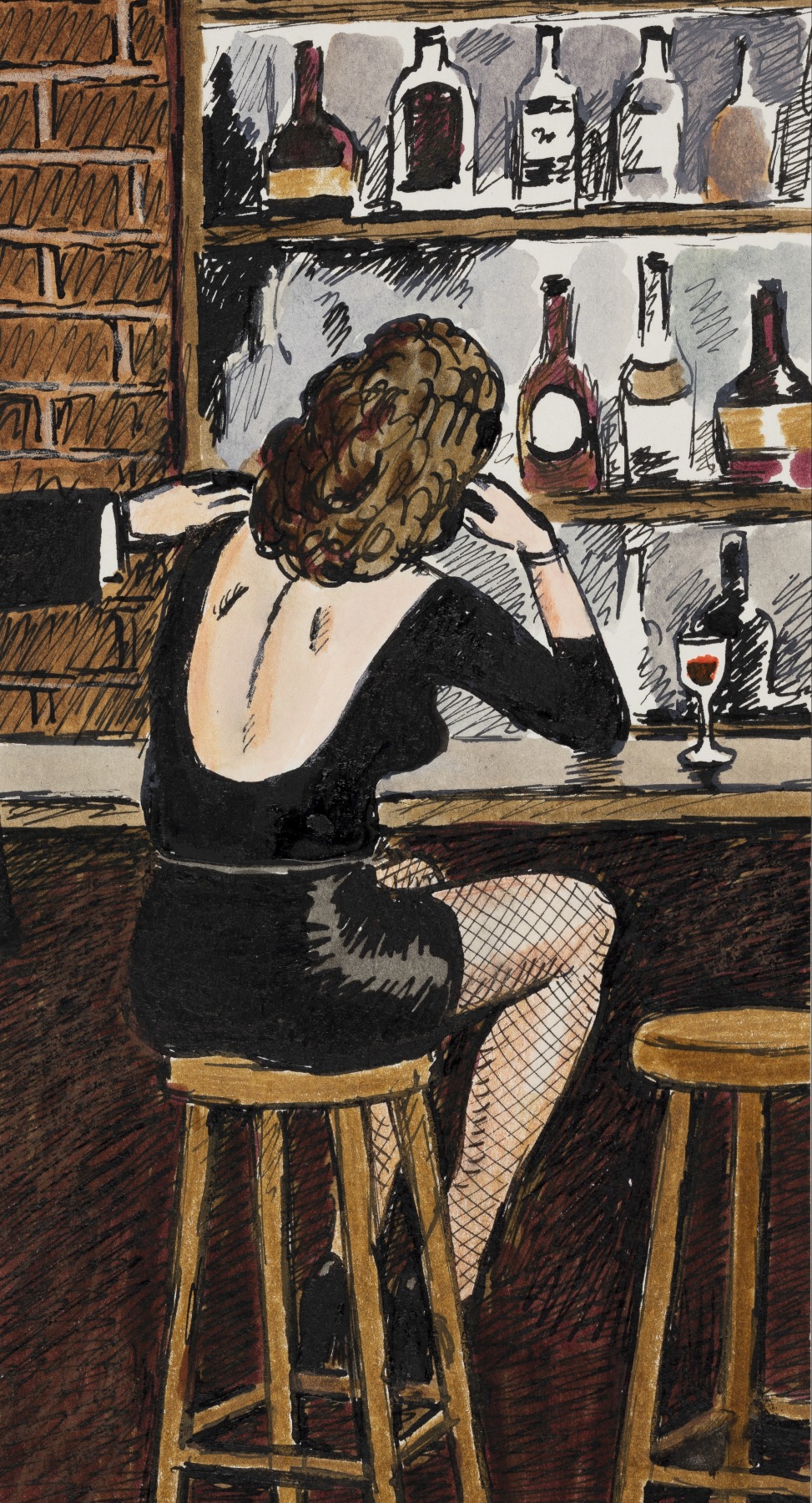
Zoya Cherkassky, Untitled, 2021
Allison Gingeras: Why did you start to depict sex workers? It’s quite a departure from our previous collaboration on Lost Time, your online exhibition at Fort Gansevoort in May 2020, there is a startling jump in subject matter from the “Plague weddings” held in Jewish cemeteries to this current series devoted to the world of sex workers. These dramatic shifts of the past 18 months seem to have registered in your drawings from the beginning of the lockdown to the ones that you are doing now… this body of work is much more human, tactile, and leads to a very physical universe of sex workers. How did you come to this subject?
Zoya Cherkassky: I think this body of work can be seen as a second episode to my practice during this past year of the pandemic. I see these drawings both as a project and as a psychological reaction to the situation. As I told you before, I never used art as psychotherapy. Before Corona, if anybody would have told me that I would do such a thing, I would not have believed them. But I think in this situation I used art in the same way I used it in my childhood. I used it to elaborate on things that were happening to me in real life. I started this project during the last lockdown in Israel, which was a bit heavy, because it was supposed to last one week and then lasted two months.
AG: When was that exactly?
ZC: It was in April 2021. And the trigger for this body of work was something that had no relation to sex workers. I encountered the story of this Russian man, Viktor Mokhov, called the “Skopin Maniac”, who about 20 years ago kidnapped two girls - Ekaterina Martynova and Elena Samokhina - who were respectively 14 and 17 years old. Mokhov kept the girls in a bunker for four years, and one of the girls gave birth to three children without any medical assistance. It was a very crazy story to read.

Zoya Cherkassky, Untitled, 2021
By a miracle, the girls managed to escape, and eventually, Mokov was arrested. His sentence was only seventeen years in prison. That was justified by the fact that he did not kill the girls, but only raped them…Now, the Skopin Maniac is out in the world and recently there was a whole feature about him on Russian TV. And you know the Russian TV is cynical as hell! They treated him like a star, inviting him to talk shows and interviewing him, and the interviewer was sort of flirting with him. All the people who are into any kind of human rights discourse were really shocked to see how welcomed he was. For me, it was extremely hard to see how celebrated he got. It was hard enough to trigger me to work on this project and bring into my work a subject that I have never really dealt with before, which is sexuality.

Zoya Cherkassky, To the School, 2015
I started these drawings without any preconception, but then I gradually realized that most of the women I was depicting were Eastern European or Post-Soviet women. In several of the drawings I ended up making, I saw characters from my previous Soviet Childhood series. For instance, there is this one drawing I am thinking about – To the School – that I made in 2015. A girl is getting ready to go to school and she is getting dressed while sitting on the bed. That girl is in a very similar room and position as the sex worker in Untitled. They have the same wallpaper behind them. I just did this unconsciously!
AG: That is interesting. As this is a new subject matter, did you look at documentary photographs? Because there is a post-Soviet tradition of documenting the sex industry.
ZC: This series moves away from the male fantasy of sex workers. It tries to break from this very masculine idea that female sex workers enjoy their jobs. It leads us to a more female perspective, where this experience is generally seen as something more complex. You know when a woman thinks about this type of work, she can imagine it like hell.
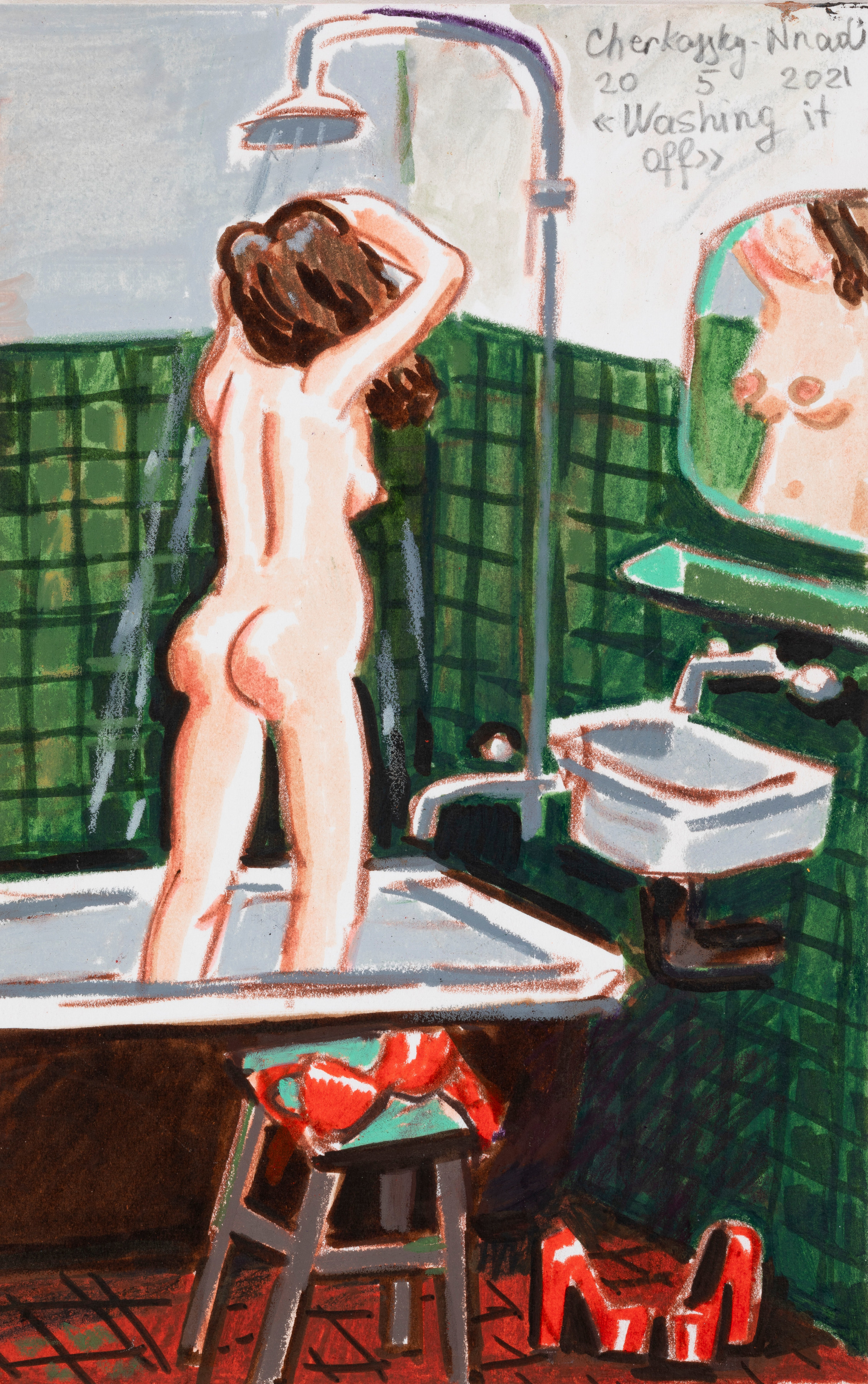
Zoya Cherkassky, Washing It Off, 2021
AG: Right! On this note, if we look at the works I selected for our conversation, you will see that I was most interested in drawings that are made from the women’s point of view. These works describe the women’s role in the industry, but also a shared sense of community and solidarity, that goes beyond whether they voluntarily or involuntarily found themselves in the sex working field. I am interested in these scenes of shared life, also because you mentioned that you used to disavow art as therapy. I would love to hear the narrative scenarios that are in these images. Let’s start with the drawing Washing It Off.
ZC: I looked at several videos of sex workers in Russia to make this body of work. In these videos, what immediately arises is that this job is still considered to be a crime in Russia. This allows the police to ambush brothels very often and then arrest everybody, which is a scene that they usually also film. But you know, the penalty that they charge is just money, and to be fair, the reason why they do this is just to get money from the sex workers.
In these videos, all kinds of weird stuff happen. For example, there are some scenes where the police film the girls while shaming them. Many of these videos are on YouTube now, accessible to everyone. I look at the scenes in these brothels and depict my own version of them. Very often, there are moments that take place in very typical post-soviet apartments, places that are familiar to me. When they can, the girls in the videos usually cover their heads with a towel, because they do not want to be filmed, or they look away and stay hidden.
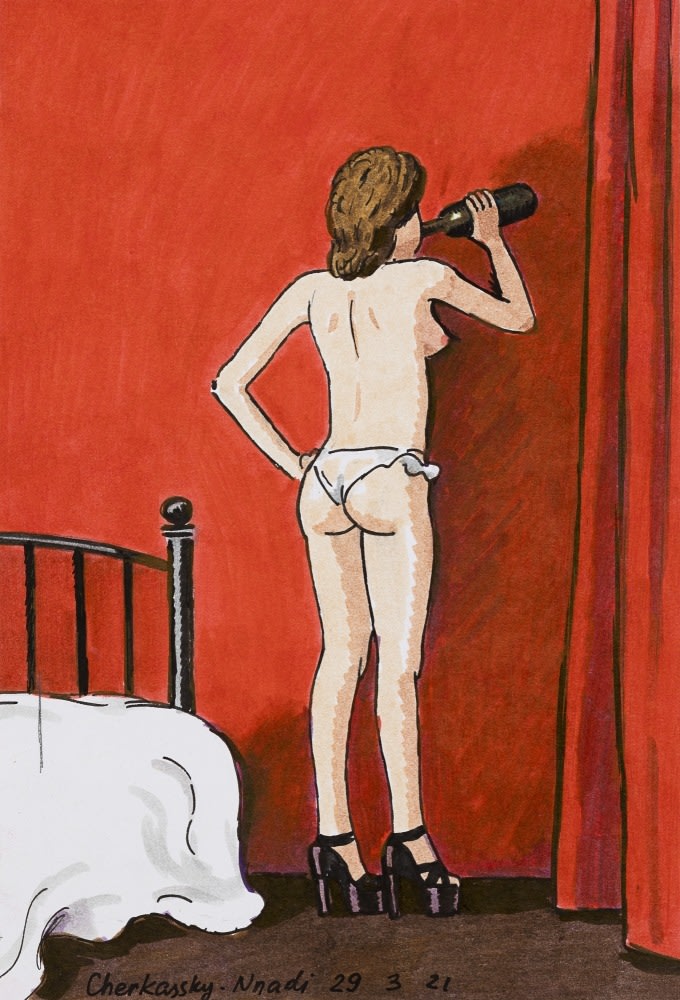
Zoya Cherkassky, Untitled, 2021
AG: Is this what you are showing us also in Washing It Off where the girl does not look out at the viewer?
ZC: Yes, but Washing It Off also stands from something completely different. I was listening to interviews and found out that very often women who start doing this work share a similar experience. After their first time, they want to wash everything off. To me, what they describe when talking about the first time at their job, is similar to how rape victims talk about their own experience.
AG: In a way, this image speaks to a feeling of shame.
ZC: It does. And I think it shows how it feels like to feel dirty and have this desire to just be alone and take a long shower.
AG: I really like these solitary figures in your drawings. For instance, in Untitled there is a woman, seen from behind, drinking directly from the bottle. She is in her underwear and wears high heels. Who is she?
ZC: This is a character I took from a movie called Intergirl (1989). It is the first Soviet movie about prostitution in the Soviet Union. She is the main character, who managed to marry a man from Sweden and eventually move there. It truly is a cult movie in the post-Soviet countries and in many ways, it describes the experience of a woman in the Soviet Union.
AG: I was wondering about the emotional temperature of this image. It feels open-ended. Is she drinking to find the courage to do her job?

Still from Intergirl (1989)
Courtesy of V. Mapeshin/Sputnik
ZC: Maybe! Or maybe she is drinking because she is done for the day. It could be both to me.
AG: Obviously there are a lot of tropes here dealing with the emotional burdens of this type of labor. There is simultaneously a sense of solidarity and lightness. In the drawing of the women laying in bed watching television, you can just feel the camaraderie amongst these women. It is interesting also because this depicts the women within a duality. There is a possibility that they are objectified for male consumption. Yet these women are in their own private world, relaxing among themselves, yet they still wear all the garb and accouterments of their day jobs.
ZC: You know, this is funny because in the picture you are pointing out the characters are watching the movie I just mentioned to you: Intergirl. You can see it on the screen! What you said is true. In many of these drawings, I depict domestic settings. I imagine these women at work, in moments where they don’t have a client around and they are just spending time together. You know, even if I personally don’t hang out with my girlfriends dressed in this way, I can see myself in this image. I showed this drawing to a friend that I usually meet up with to go watch TV at another’s friend house. She looked at the image and said: “Oh, this is Friday evening at Diana’s!”.
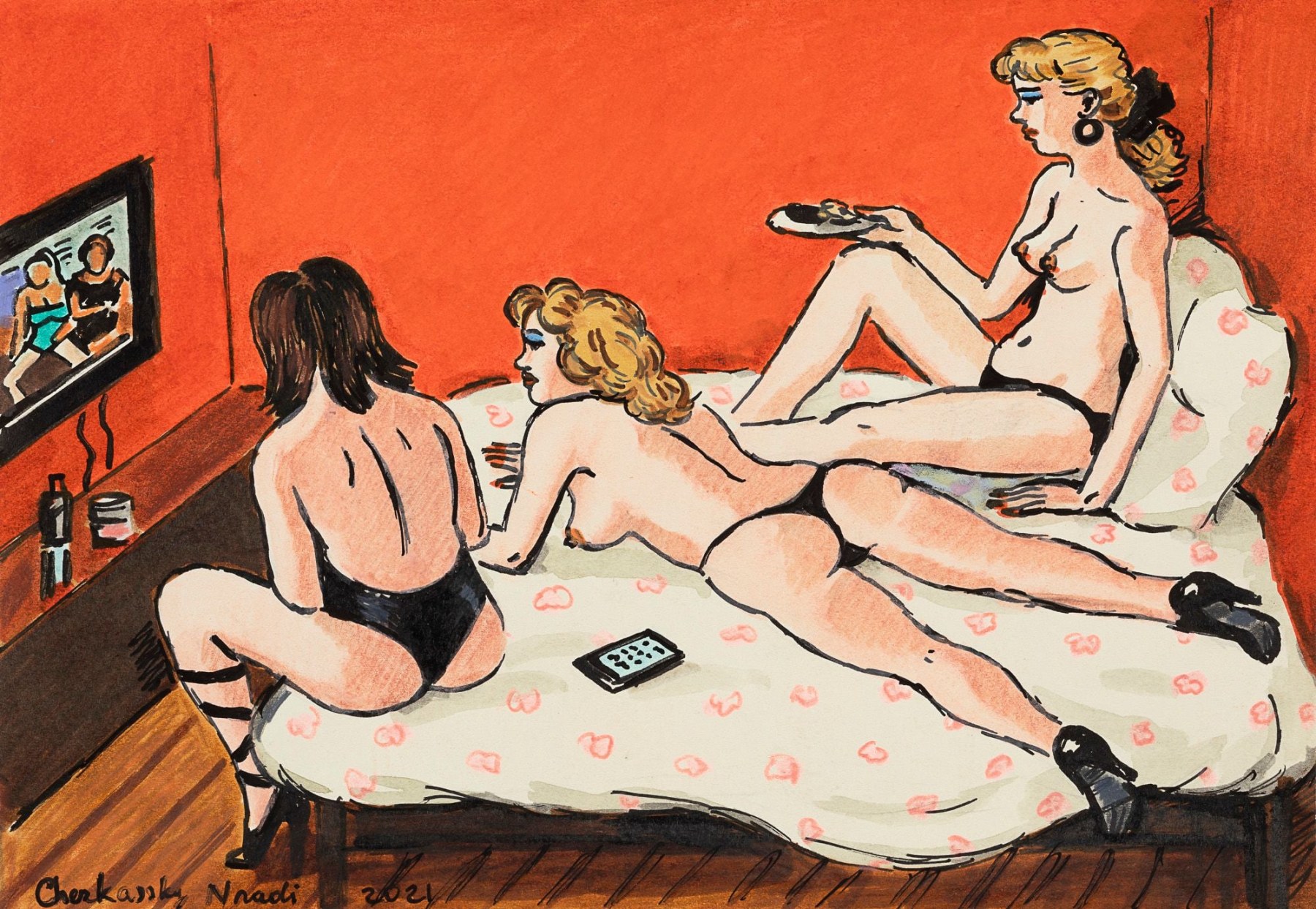
Zoya Cherkassky, Untitled, 2021
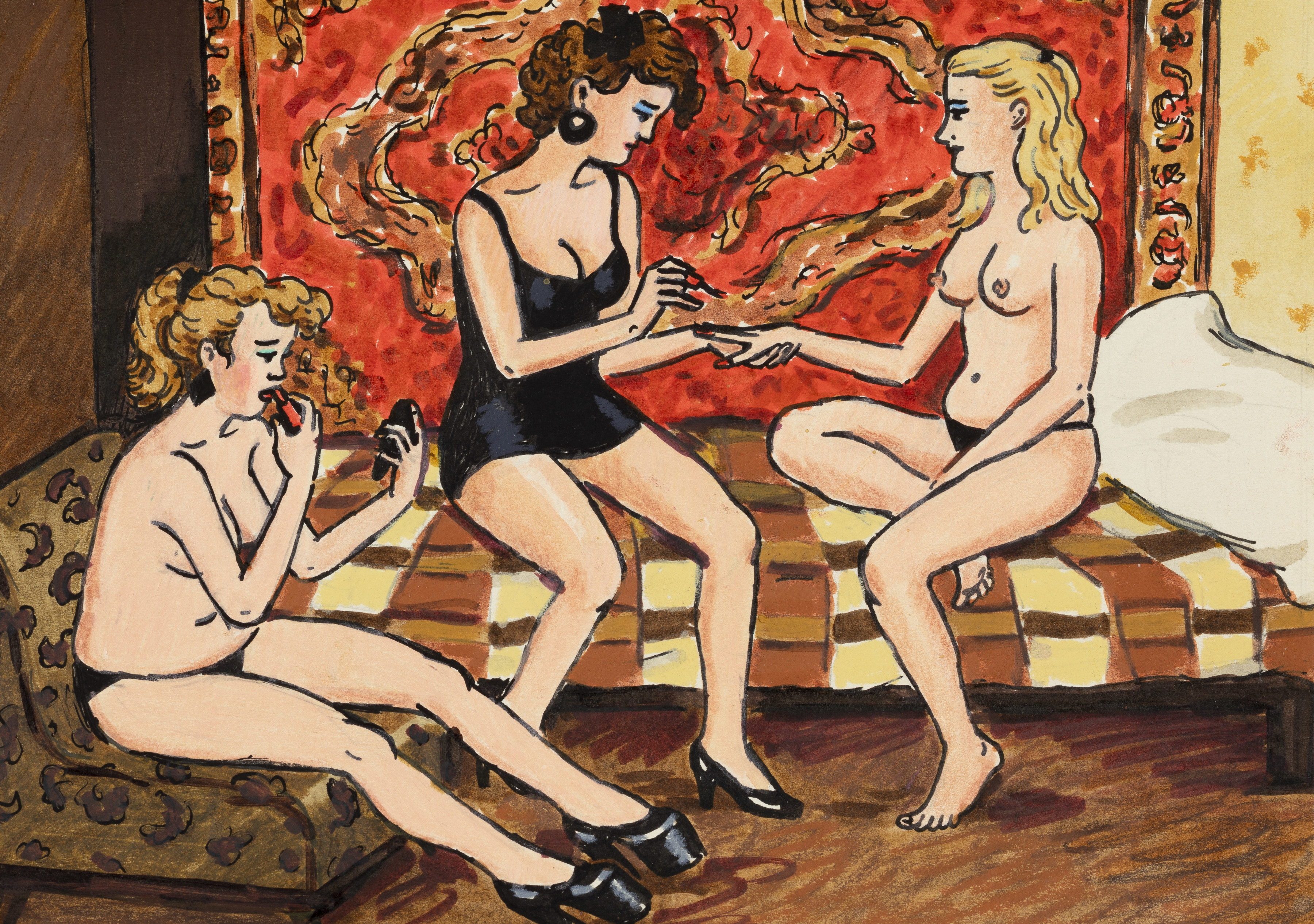
Zoya Cherkassky, Nail Polish, 2021
AG: This leads me to another drawing that I like, where a group of women are doing their nails. This is such a universal experience of girls bonding! A classic trope of women coming of age together, doing each other's makeup or nails. But here these women are semi-naked. In this image, there is once again the push and the pull of the universal male fantasy. It adds another layer of fantasy, which is not just the one around the sex act that the male client pays for, but also this idea about a house, a brothel, that is full of semi-dressed women that spend time together, don’t you think?
ZC: Definitely! I took this idea from one of the videos. These are real scenes and in this one house, there was a kitchen that looked just like mine. And these women, they are there, making tea and it looks like a very domestic situation between the girlfriends, but they are all dressed in sexualized clothing. And on top of it, they all look like the girl next door! They are not modeling, you know? They are normal people.
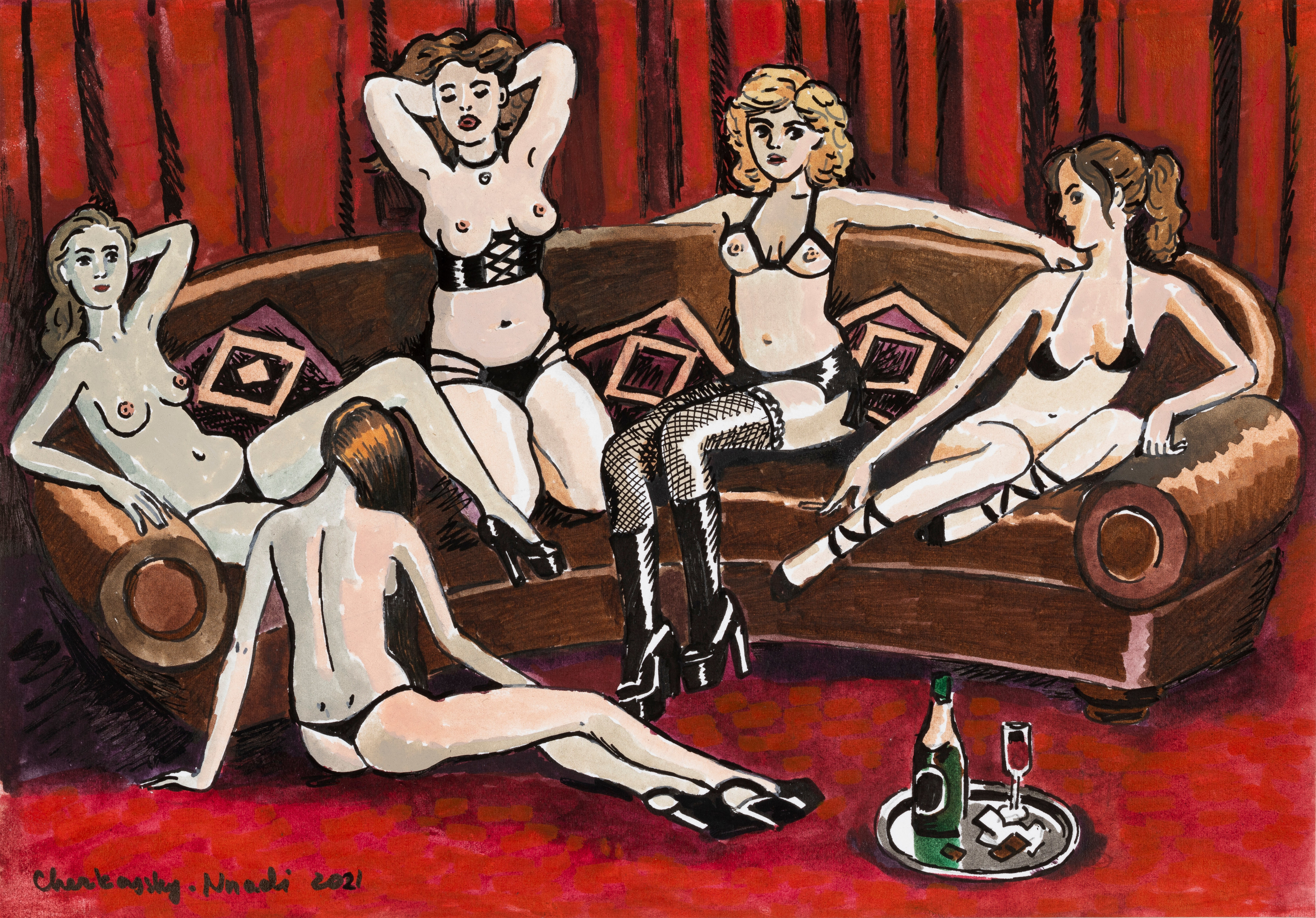
Zoya Cherkassky, Untitled, 2021
AG: What I also find interesting in these images depicting groups of girlfriends, is the contrast between the girls in private and then the girls who are putting themselves for sale so to speak, or up for consumption. Let’s look at the Untitled drawing of women posing on a large couch. In this image what immediately stands out to me is the posturing of these women that conjure different art historical precedents. Were you thinking at all about that?
ZC: Yes! Throughout the works, I mostly refer to Henri de Toulouse-Lautrec, not as much in the style, but in the composition and subjects.
AG: There is an overarching aspect of this body of work: we have a hard time gauging your position. You are not necessarily criticizing or negating the practice of sex work. The judgment is ambiguous in terms of where you stand. Is that an accurate perception?
ZC: That is correct! Usually, in all my projects I avoid giving an answer to the audience. I avoid giving the impression that one should feel in a certain way about the subjects I present. Ultimately, I try to confuse the viewer with the visual material that I put in front of them.
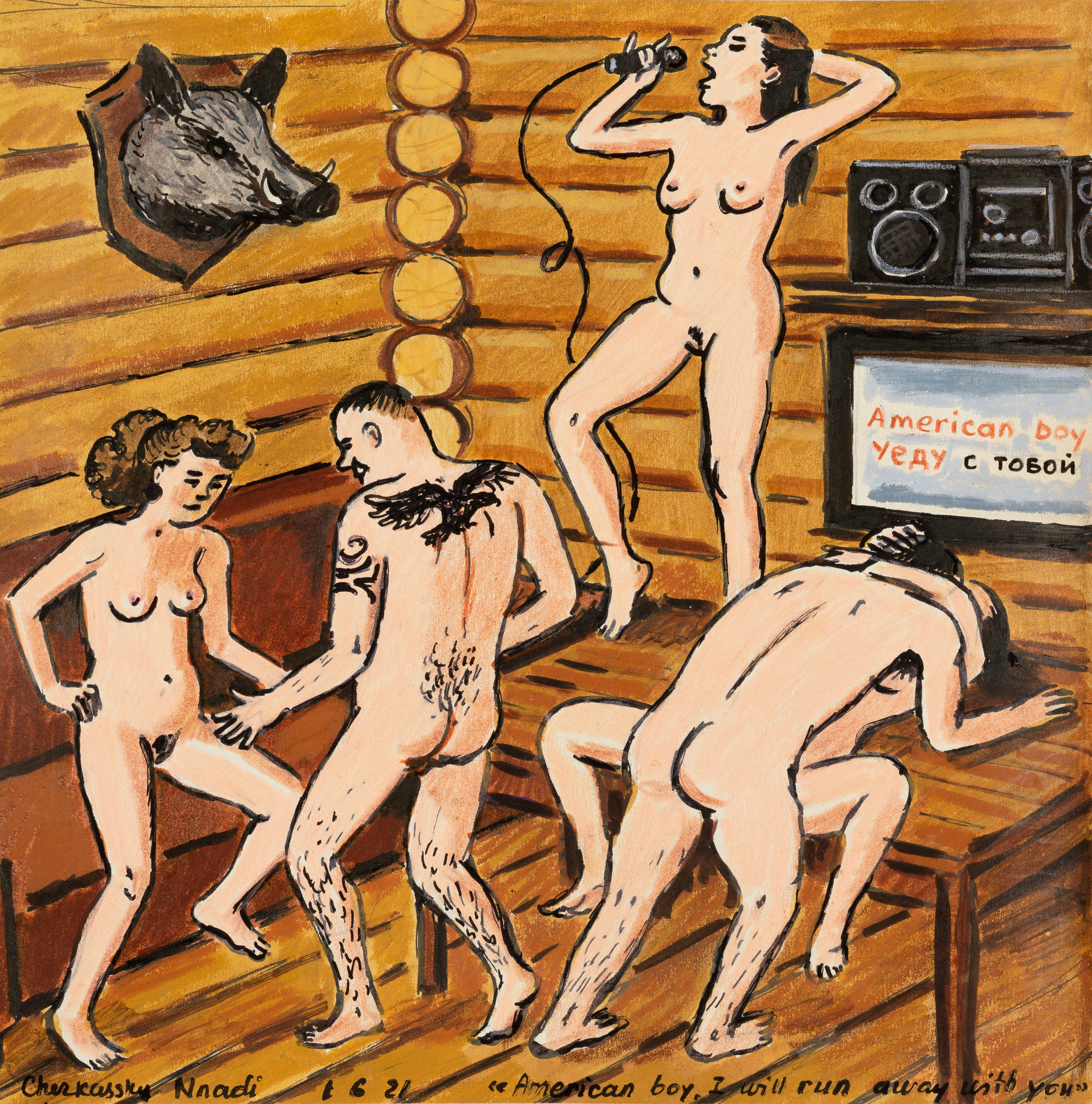
Zoya Cherkassky, American Boy, I Will Run Away With You, 2021
AG: And in a similar way to Lautrec, there is a certain implicit romanticization or fetishization of the sex worker, is that right?
ZC: For sure. And some of these sex workers are also funny. Take the drawings I made where they are singing in the sauna karaoke, for instance. These scenes are important to me because they present diverse types of perceptions. In one of these drawings, a woman is singing “American boy I will ride away with you.” There was a time when Soviet girls were dreaming of running abroad with a man from America. Many of them got engaged in sex trafficking because of this romantic dream.
AG: I think the fact that you try to use a certain amount of objectivity in presenting these different vignettes and scenes is by default a sex-positive, feminist point of view. I mean you are not denouncing sex work; you are presenting it. This makes me think about an organization in the US, which I believe became international. It was called Coyote: Call Off Your Old Tired Ethics. Margo St James started it as an association of sex workers and lawyers who supported feminists and the right to engage in sex work. It validated sex as a job, as a form of labor like any other. And in a way, I see your approach here being more in that vein. Your subjects are just “Women Who Work.”
ZC: Although this perception comes across, I ultimately drift away from having an opinion on this topic because you know, I am not immersed in this discourse enough to feel confident with taking sides.
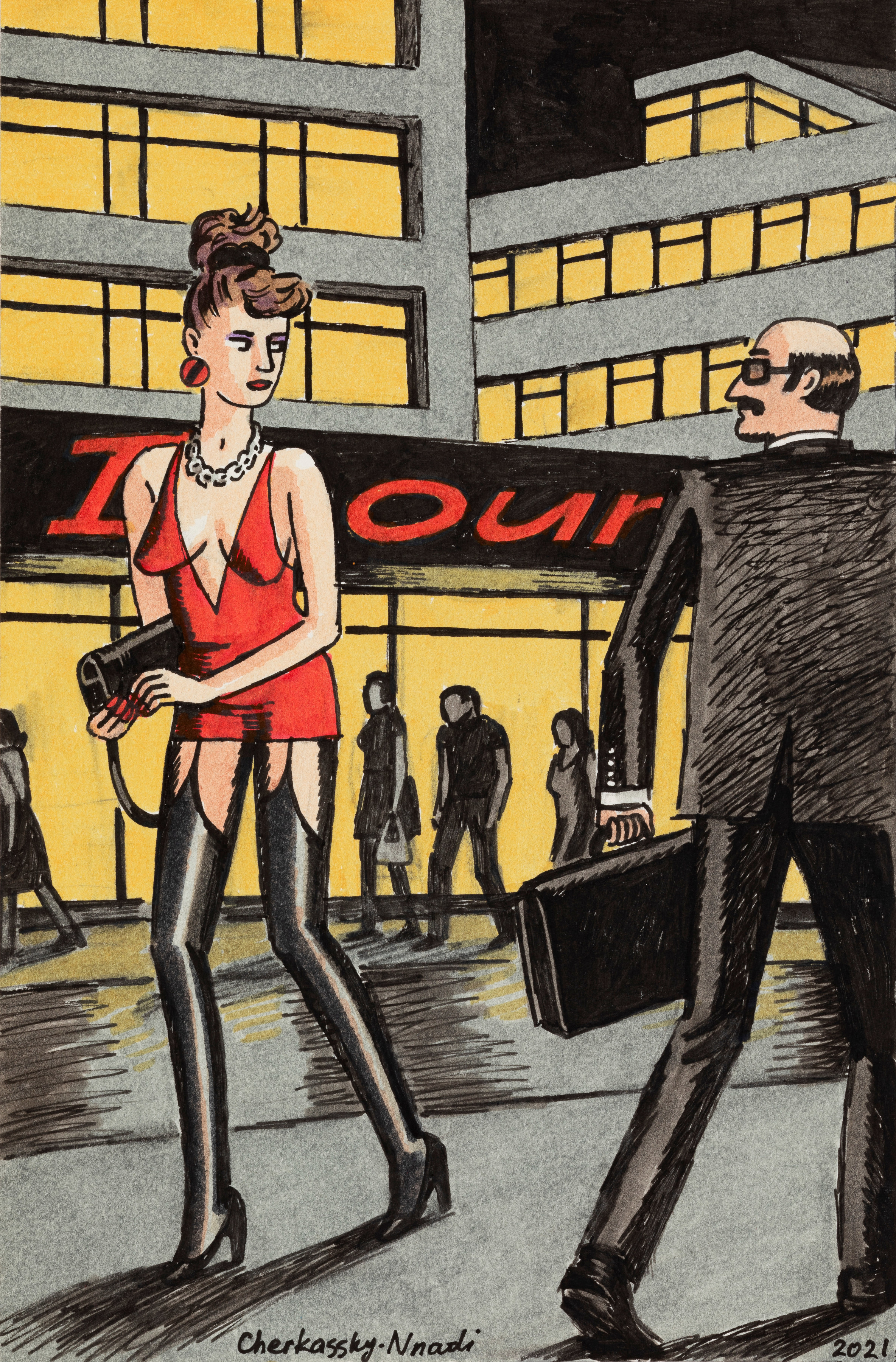
Zoya Cherkassky, Untitled, 2021
AG: I am wondering if there is some allegorical reading that we could have about this subject matter. Is there an allegory here for you?
ZC: I don’t believe there is one. You were right when you said that I'm trying to draw these scenes that I find in videos and interviews as objectively as possible, but I obviously cannot be fully objective because, you know, it's me drawing the scenes!
AG: I know this is a part of your larger investigation too, but in this body of work you again exhume the Soviet experience. Let’s get back to the image with these women sitting on the sofa. This room, it could be anywhere in the world, but then you insert these signifiers, like the way the couch is drawn and the little details that make it rooted in a specific, geopolitical place.
ZC: You know, like many Eastern European women, especially Ukrainians, I have the name of a prostitute. Here in Israel, Russian prostitution is a very common thing, because we are also immigrants. I was dealing with this question in my previous projects. I talked to my girlfriends and every one of them had this shared experience of being offered money in exchange for sex at the age of 12. We were all seen as poor, white women with a connotation of ‘easy to get'. And on top of this, the neighborhood where my studio is located has a very active night scene. Even in the day, there are a lot of sex workers who are heavy drug addicts and in extreme conditions. I would say that 90% of them are Russian. But I did not portray these scenes. I just did not want to go to the margins.
AG: Something I noticed is that there are only a few places where we have male figures in the drawings. For instance, there is this one, where we see a woman with a red dress making eye contact with a sleazy businessman on the street.
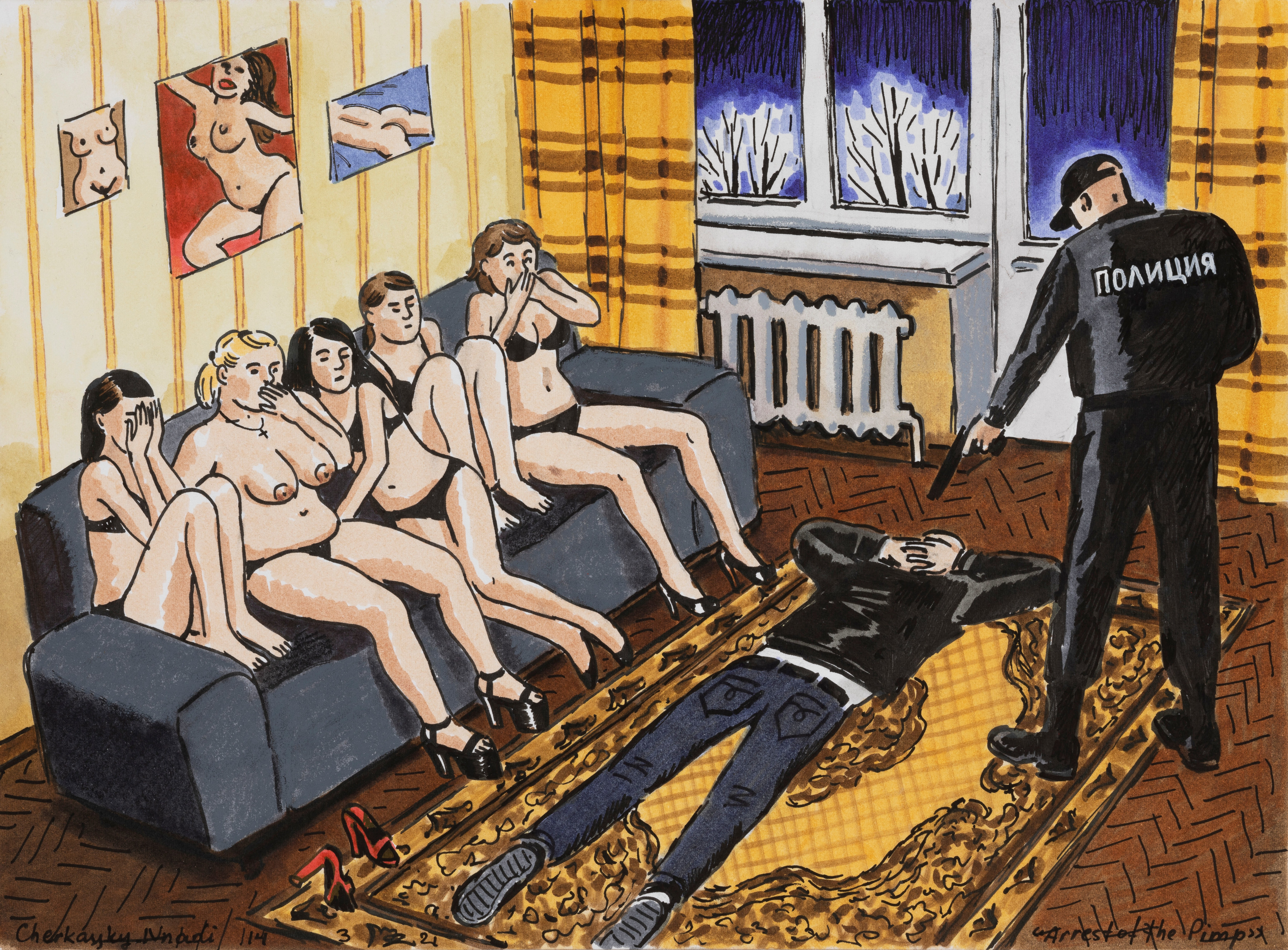
Zoya Cherkassky, Arrest of the Pimp, 2021
ZC: This woman is in front of the hotel called Intourist. It is the hotel where you meet clients from abroad that will pay in dollars. There is one in all the big cities.
AG: And there is this other image with a man, where we see a suggestion of direct violence and danger. I like this image a lot and I thought it was important to highlight it. The women are here together, on the couch, but they are not the main subjects, they are an audience. At the same time, they are also having this collective moment that is very different from the one they are having in the previous image, where they are sitting on a couch. Here, they are sharing a sense of fear.
ZC: This is an image that I drew from the police raids that I watched in the videos we talked about. This is indeed a very violent scene. The men always end up on the ground. And the women, they are usually scared and hiding.
AG: It's interesting. It sounds like most of your inspiration for the series is rooted in YouTube videos.
ZC: It is not only YouTube videos. I reference a lot of post-Soviet movies about organized crime. In these movies, there are always episodes of sex trafficking, even if the movie itself is not about it.
AG: Is there something else that you think we should discuss about these works?
ZC: I would like to point out one last work, Le Déjeuner Sur L'Herbe. It is a funny one, but more importantly, it is anecdotic. And it is important for this project because there is a general stigma about prostitutes and all these jokes about sex workers and I try to bring this reality up by using Le Déjeuner Sur L'Herbe as a title for this work. There are a lot of situations where sex is regarded as funny. This is a controversial image. It immediately leads us to porn, but also it leads us to this inside joke. And it was important for me to include images in this body of work that would make the audience feel uncomfortable because this is when a conversation can take place.
In Le Déjeuner Sur L'Herbe by Édouard Manet there is this naked woman and the dressed men. The image led to many debates, but here, it is not even clear that these are sex workers. It could be a group of friends!
AG: That is what happened at the picnic after Manet left!
It's great to conclude with an art-historical joke; humor and ambiguity are at the core of your practice. Are these women being exploited or is this consensual? The answer is open-ended.